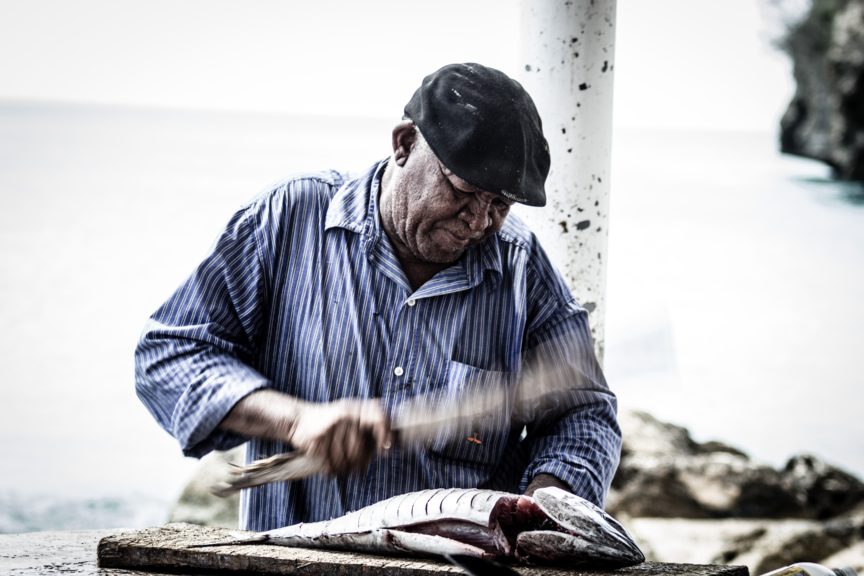Simplicity and Tradition on the Costa del Sol
A visit in late March of this year to the beach communities of Andalusia gave me an opportunity to reacquaint myself with the clarity and wonder of Spanish life. A fortnight of exploring, eating, drinking, talking, staying up past my accustomed hours, and walking, walking, walking reminded me that living well does not require affluence, and spending lavishly does not guarantee access to the most meaningful and pleasurable experiences. With their famous hours-long mid-day meals, their devotion to the cohesion of the family, and, above all, their refinement in culinary and vinous arts, the Spanish people of the south elevate the little details of daily life into matters of national importance.

Shrimp, squid, octopus, anchovies, sardines, et. al, at Mercadona. Photo, Maxwell
The Freshest Catch
The quality, freshness, and variety of seafood in average neighborhood supermarkets in Andalucia are mind-boggling. There is no fishy aroma of any kind in the laboratory-like, immaculate seafood departments. The offerings look as if they could still be alive.
It goes without saying that restaurants have similarly astonishing raw materials to work with. The finest, freshest ingredients, prepared unostentatiously and with a light hand, produce food that delights with its delicious purity and simplicity.
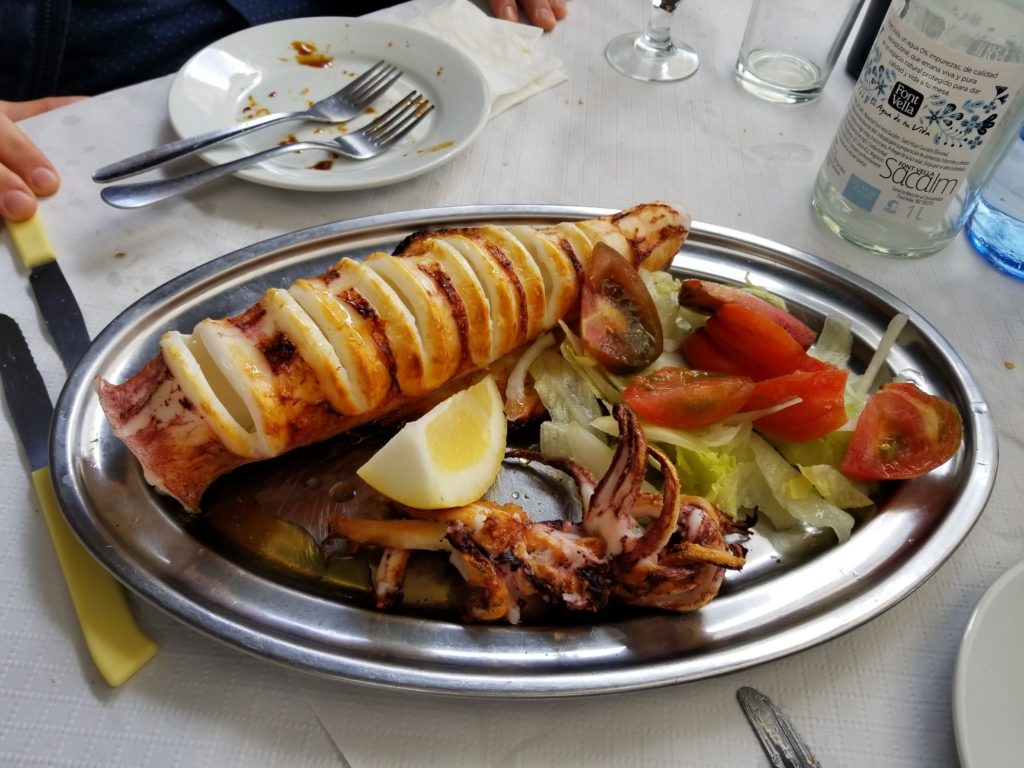
Calamari from Malaga, grilled on a stick beside a wood fire; served with lemon and a spartan salad of tomatoes and lettuce. Photo, Maxwell
Boquerones–tiny white anchovies that are one of Andalusia’s most popular foods–are dusted in flour with salt and pepper and quickly fried to create a light, airy delicacy. These exquisite creatures possess a slightly briny, sweet flavor–they are so delicious it is difficult to stop eating them.
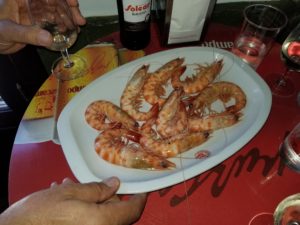
A serving of Sanlucar langostinos at the Casa Balbino. Photo, Maxwell
Langostinos–at the mouth of the Guadalquivir River in western Andalusia, fresh river water flows into the salt water of the Gulf of Cadiz and creates a salutary environment for one of the region’s other delicacies, the King Prawn of Sanlucar. This prawn is a species distinct from all others in the world and is an expression of the extraordinary biodiversity of the Guadalquivir Delta. The best of these distinguished crustaceans come from a protected fishery adjacent to Donana National Park, a UNESCO World Heritage Site. They are prized for their sweet, fresh, oceanic flavor. The only preparation required is a brief plunge into boiling water with just the correct dash of salt.
The calamari, boquerones, and langostinos pair perfectly with cold beer, fino and manzanilla 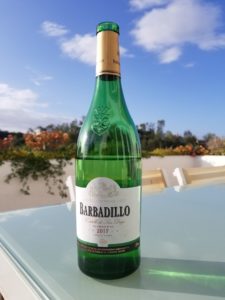 sherry, or fresh white wines like the Barbadillo Palomino depicted below. This wine’s flavor of fresh fruit and an almond-like nuance complements and develops the buttery flavors of the seafood and keeps the palate alive for more eating. Its suitability for this cuisine has helped to make it the most popular white wine in Spain.
sherry, or fresh white wines like the Barbadillo Palomino depicted below. This wine’s flavor of fresh fruit and an almond-like nuance complements and develops the buttery flavors of the seafood and keeps the palate alive for more eating. Its suitability for this cuisine has helped to make it the most popular white wine in Spain.
The Mountains are Never Far Away
Thirty-nine miles into the Sierras north of Marbella, perches the town Ronda. Occupied over the last two millenia by the original Iberians, the Romans, the Celts, several waves of Moors, Christians, Franco’s fascists, and now its current Andalusians, most of whom viewed the locale as a protection from invaders and an escape from the madding crowd on the coastal plain below, the fortress-town seems cut off from the rest of the province by its giddy mountainous location. The emblem for this isolation would have to be the bridge entering the town.
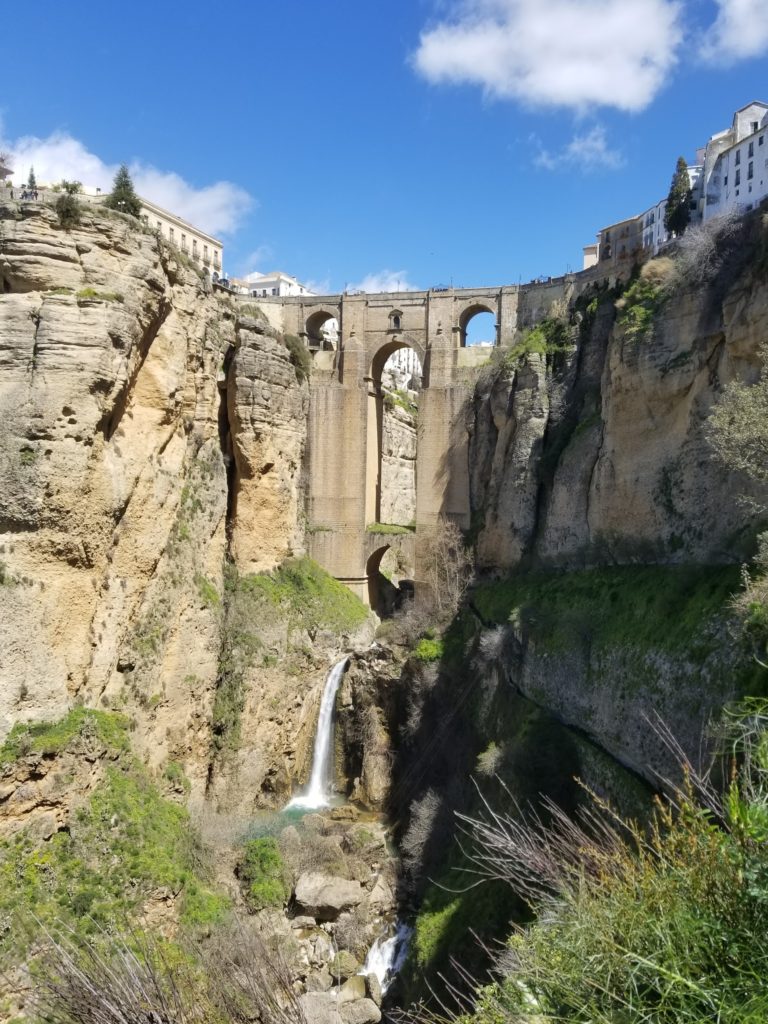
The bridge into Ronda. Photo, Maxwell
In keeping with that historical function, Ronda’s shops and restaurants display more of the rustic foodstuffs and farm produce from Andalusia’s interior than I saw along the coast. To be sure, there is still plenty of seafood on menus, but it seems to be concentrated in higher-end establishments whose affluent clientele can afford the extra expense of transporting fish from the coast. One afternoon during Holy Week, we wandered through the streets and detected signs of this shift at food markets and restaurants. We saw much more in the way of various preparations of goat and goat cheese, lamb and mutton, chicken, pig’s ears, pig’s cheeks, pork ribs, jamon, roast suckling pig, sausage, wild game, and, above all, beef.
There is a reason for all the beef. One of Spain’s important bullrings is in Ronda, along with a museum celebrating that oddity of Spanish culture, both facts underscoring the primacy of livestock in these mountains. When hunger began to gnaw at us after miles of wandering through the streets in a chilly wind, we stumbled into a tapas bar Hemingway himself could have frequented and knelt at the altar of beef. We ordered the dish Ronda is known for–bull tail stew.
Rabo de toro, as it is called, is simple enough: several pounds of bull tail, carrots, onion, red pepper, leeks, tomatoes, garlic, sherry, flour, stock, and spices. The hard part of preparing it is having the patience to cook it long enough for the gristly, tough meat to fall off the bones. Ours had been cooked for hours to an eminent degree of tenderness. We ladled it into our mouths with giant spoons and sponged the sauce out of the tureen with chunks of bread. The gut-filling stew, the homey surroundings of the bar, and the brilliant sunshine streaming in through the windows helped us recover from the raw spring weather outside.
But there was another thought, one that makes eating this way relevant to anybody. For the most part, the Spanish don’t talk this way about their food, but it is intensely locavoric. They use the ingredients available to them, their livestock, the marine life swimming off their beaches, the edible plants growing in their neighborhoods, etc., to eat well without poisoning the natural world, exploiting captive workers, or manipulating consumers to eat things from far away that aren’t as wholesome as they should be. It is an inspiring way to live.
 For the past twenty-three years, I’ve worked in the wine importing and distribution business. Visiting vineyards and wineries in the various wine-growing regions of the world, I make arrangements for the bottling, labeling, packaging, and shipping of wines I bring to market. These multi-faceted commercial activities have given me a valuable education I could have acquired in no other way. The majority of my studies unfolded in California. There, in that place, and with access to nearly every bottled wine known to humankind, I learned to savor the fruit of the vine.
For the past twenty-three years, I’ve worked in the wine importing and distribution business. Visiting vineyards and wineries in the various wine-growing regions of the world, I make arrangements for the bottling, labeling, packaging, and shipping of wines I bring to market. These multi-faceted commercial activities have given me a valuable education I could have acquired in no other way. The majority of my studies unfolded in California. There, in that place, and with access to nearly every bottled wine known to humankind, I learned to savor the fruit of the vine.

